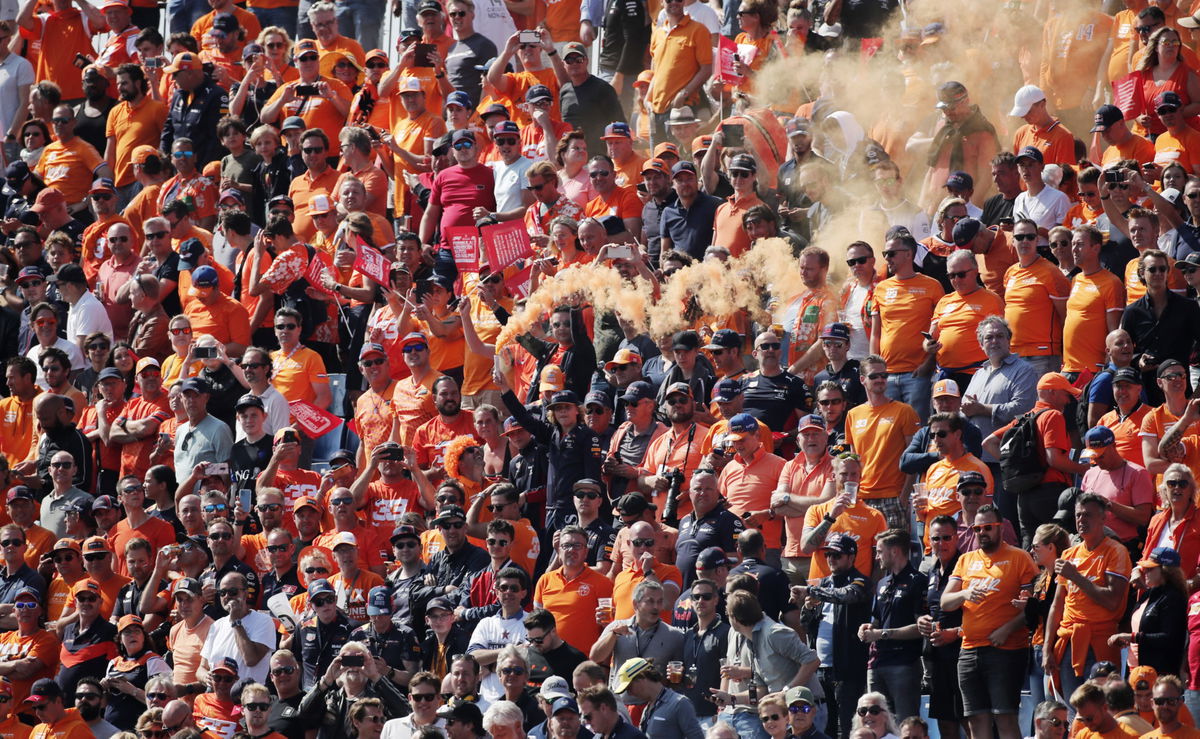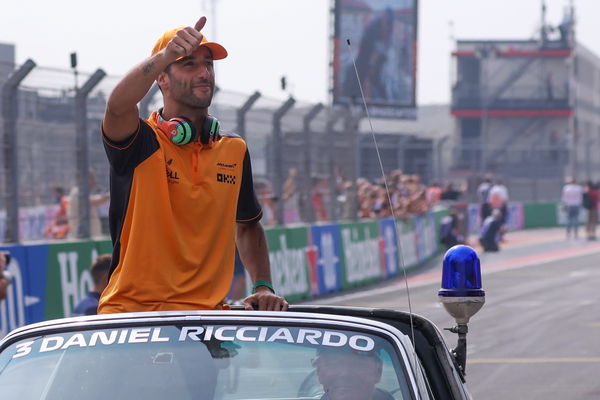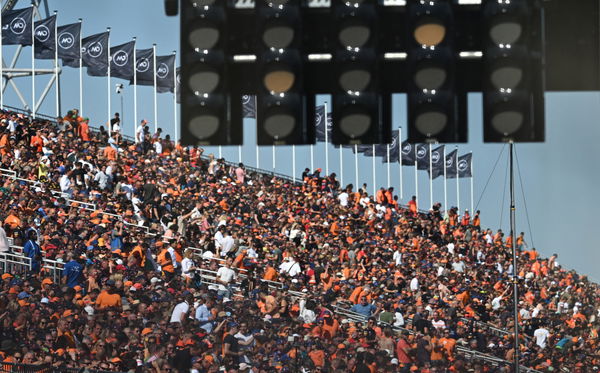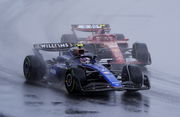
Reuters
Formula One F1 – Dutch Grand Prix – Circuit Zandvoort, Zandvoort, Netherlands – September 5, 2021 Fans are seen in the stand before the race REUTERS/Benoit Tessier

Reuters
Formula One F1 – Dutch Grand Prix – Circuit Zandvoort, Zandvoort, Netherlands – September 5, 2021 Fans are seen in the stand before the race REUTERS/Benoit Tessier
As the home race of F1’s reigning World Champion, the Dutch GP has to bring some excitement to the table, right? The upcoming race in Max Verstappen’s country will be the first one after a long summer break. And to change things up, the Zandvoort circuit will feature a unique part called ‘banking’ that you might not find at other circuits on this season’s roster. The idea behind the baking of the race track hatched when the late FIA Race Director, Charlie Whiting, wanted to emulate the Indianapolis track where the United States GP took place between 2000 and 2007.
Watch What’s Trending Now!
Now, you might be wondering what “banking of the race track” means. It is the process of giving some incline to the turns of the track, usually leading down towards the apex of the race track. So, when a car goes around those turns, it actually goes up an elevation and then comes down again. Describing the experience of how it might feel to race through the banked circuit of Zandvoort, circuit designer Jarno Zaffelli once said, “All of your horizon is tilting, all of your perception is evolving, you feel like you are being squeezed. It’s like being in a corkscrew.” And the need to see the F1 racers take on such a different kind of a track is what the organizers believe will draw more fans to the Dutch GP.

Getty
ZANDVOORT, NETHERLANDS – SEPTEMBER 4: Daniel Ricciardo of Australia and McLaren during Race during of the Formula 1 Dutch Grand Prix at Cicuit Zandvoort on September 4, 2022 in Zandvoort, Netherlands (Photo by Marcel ter Bals/BSR Agency/Getty Images)
But banking is not something that the other race tracks have gotten till now. So, what was the motivation behind the Zandvoort organizers trying to incorporate this change into their track?
ADVERTISEMENT
The idea behind the ‘banking’ of the Zandvoort track
Every year, the Formula 1 calendar features a host of different racing circuits that are unique in their own right. While there are the iconic Eau Rouge and Raidillon at Spa-Francorchamps in Belgium, there are also the historic Maggots and Becketts of Silverstone. To stand out amongst the gorgeous race tracks that have already made a place in the F1 world, Zandvoort needed its ticket to fame. And that is how the organizers decided they would bring the element of banking to F1.
ADVERTISEMENT
So, when the FIA announced that Formula 1 racing would resume at the Zandvoort circuit in 2019, the work began on renovating the track right away. The Italian Circuit design company, Dromo, took on the challenge of giving a makeover to the pre-World War 2 circuit. As its founder, Jarno Zaffelli talked about the vision he had in the back of his mind while working on the Zandvoort track.

Reuters
Formula One F1 – Dutch Grand Prix – Circuit Zandvoort, Zandvoort, Netherlands – September 3, 2022 Fans during qualifying Pool via REUTERS/Christian Bruna
He said to Formula 1, “We did something that we thought would be really formidable to drive, that has no equal at any other racetracks.” Thus, this is how the plans led to the banked turns of Zandvoort. But how are these elements any different from the banked turns at the Indianapolis Motor Speedway?
ADVERTISEMENT
Zandvoort versus Indianapolis: The Battle of the Angles
To understand the difference between the two tracks that are separated by the Atlantic Ocean in between them, we will first talk about the track design of Zandvoort. It has a circuit length of 4.259 km and there are 14 turns over this entire stretch. Turn 3 (which derives its name from former circuit director John Hugenholtz) and Turn 14 (named after two-time Indianapolis 500 winner Arie Luyendyk), are the ones that have the banking feature.
ADVERTISEMENT
Now, the Indianapolis track has inclinations of 9° whereas the bankings at Zandvoort have an angle of 19°. Thus, the degree of banking at the Dutch circuit is more than double that at the Indianapolis Motor Speedway, which means the racers at Zandvoort will experience a bigger centripetal force that will pull the cars toward the center of the track. Moreover, the challenge is on those brave men of F1 as they need to preserve their tires and go around those banked turns as fast as they can to finally clinch the title of the Dutch GP 2024 winner.
Top Stories
How F1’s 2026 Engine Rules Sound Alarm Bells for NASCAR and Others? – Explained

Max Verstappen’s Siblings: Everything We Know About Victoria, Blue Jaye, Jason Jaxx, and Mila Faye

Who Are Lando Norris’s Parents? Meet Adam Norris and Cisca Wauman

Mercedes Boss Toto Wolff Contradicts His Daughter on F1’s Age-Old Issue Amid Cheering for His Better Half Susie Wolff

“Took a Scandal for Alexandra”: Fans Unleash Hell at Charles Leclerc’s GF for PR Antics to Undo Past

How dangerous are these banked corners of Zandvoort?
Any track in F1 can be a death trap for the racers since they travel through the twists and turns at speeds north of 200 mph. However, the Dutch GP organizers needed to take some special steps to ensure driver safety as the banked corners can quickly turn dangerous. The high centripetal force of the tracks can lead the cars to crash with the opposite boundary wall if the racers lose control. To make sure that the impacts of those crashes can be curbed to the most minimal level, the Dutch GP authorities announced some new measures.
ADVERTISEMENT

ADVERTISEMENT
The Zandvoort track has a layer of Tarmac which comes with the nickname of the ‘Flying Dutch’ after Max Verstappen. This can slow down the cars that might go hurtling towards the side walls. Additionally, the debris fences are present at 90° angles to the turns which have banking. And there are the new SAFER barriers which can absorb most of the impact if any car crashes into them while going around the banked turns. So, even if the turns are quite dangerous as per the laws of Physics, the Zandvoort people have seen to it that they do not compromise on safety.
Are there any other F1 tracks that had banked corners in the past?
At the very beginning of our discussion, we stated that none of the race tracks have banking at present. However, there are some historic circuits that used to have banked corners back in the day. In fact, the angles of those corners were even higher than the ones we will see at Zandvoort. For example, the previous layout of the Monza circuit (which hosts the Italian GP) had a banking of 22 degrees. The Daytona International Speedway in Florida (which hosts the 24 Hours of Daytona endurance race) also banked the corners which recorded the highest angle of 31 degrees.
ADVERTISEMENT

Reuters
Formula One F1 – Italian Grand Prix – Autodromo Nazionale Monza, Monza, Italy – September 3, 2023 Ferrari’s Charles Leclerc ahead of the Grand Prix REUTERS/Jennifer Lorenzini
Speaking highly of the last banked corner of Zandvoort, the track CEO Robert van Overdijk had once claimed, “That corner will for sure be the most spectacular part of our renewed circuit. The corner will be banked 32% [which means, at 19°]. So the difference in height from the bottom of the corner to the top will be around four and a half metres. That’s considerable. We are in fact making an American corner on an otherwise European circuit. That is absolutely unique.”
Indeed, the Zandvoort Circuit is unique because of this banking feature. So, who do you think will win at the race track once the F1 circus moves to the Netherlands for the Dutch GP? Let us know in the comments below.
ADVERTISEMENT
ADVERTISEMENT
ADVERTISEMENT
ADVERTISEMENT

